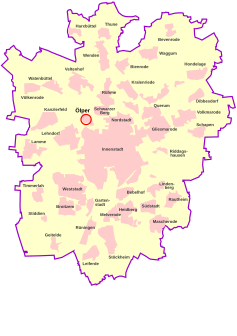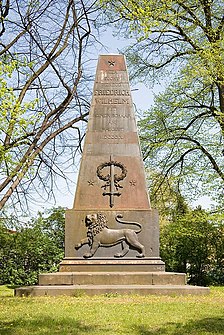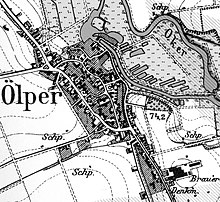Oil per
|
Oil per
City of Braunschweig
|
|
|---|---|
| Coordinates: 52 ° 17 ′ 10 ″ N , 10 ° 29 ′ 48 ″ E | |
| Height : | 77 m above sea level NN |
| Residents : | 1492 (December 31, 2015) |
| Incorporation : | 1934 |
| Postal code : | 38114 |
| Area code : | 0531 |
|
Location of Ölper in Braunschweig
|
|
|
Obelisk in memory of the battle near Ölper on August 1, 1809
|
|
Ölper is a district in the north of the city of Braunschweig . The place lies between the Oker and the A391 . Ölper is part of the city district 321 - Lehndorf-Watenbüttel and forms the statistical district 36 of Braunschweig.
history
In 1251 the village of Ölper is mentioned for the first time in a deed to the Blasius-Stift by the Bishop of Hildesheim under the name "Elbere". The first settlement, however, is likely to be further back. The property that belonged to Ölper extended from the Chancellor's field over the Ölper forest to the Eichtal. In 1393, as the landlord, the monastery signed a contract with the city to build a "Berchfriede" in the Braunschweiger Landwehr , a stone "waiting tower" at the entrance to Celler Heerstraße. From that time on, Ölper was one of three stake villages west of the Oker that were used for defense. Together with the Braunschweig Landwehr, these formed an upstream defense line for the city of Braunschweig until 1671. The oldest surviving building in Ölper, the old building of the Ölper Tower from 1642 , was also used for this purpose. As early as 1398, it was first mentioned in a chronicle as "to dem nyen torne vor Elbere", so it can be assumed that it already had one had wooden predecessors; Council bills from 1388 seem to confirm this. In peacetime, the tower served as a relaxation station and customs post. After the battle at Ölper , the tower passed into private ownership in 1765 and was demolished in 1825.
When the Black Duke was caught by Westphalian troops in the north of Ölper on his way into exile in England in 1809 , there were some skirmishes there, in the course of which the attackers (Napoleon's allies) withdrew. An obelisk at the southern entrance to the village commemorates this so-called " Battle of Ölper ".
Despite everything, for centuries Ölper was an independent farming village made up of Großkotsassen with its center on Celler Heerstraße and Dorfstraße. In the 17th century the settlement of Kleinkotsassen, who had settled on Heerstraße, was added to the west. In the 19th century, the village continued to grow in a north and south direction.
Since its incorporation in 1934, Ölper has officially been part of the city of Braunschweig.
General
Ölper is known for the motorway junction, the so-called "Ölper Knot", which was created from 1974 to 1978 when the western city motorway was built. In the east of the district is the 15.85 hectare oil lake , which was created by extracting the gravel for the embankment of the Tangentendamm. Since then, the Oker has flowed directly past the village through the former mill ditch.
- Curiosities
In and around Braunschweig, the phrase changing to oil refers to vomiting as a result of excessive alcohol consumption.
The phrase ne Ölpersche is used for a "sloshing cup". Whether the origin is due to the lavishly serving Ölper gastronomy or the flooded meadows cannot be found in the sources.
Attractions
- The Ölper Mühle was the largest urban mill with eleven grinding courses and thus formed an important economic factor for the city. In the middle of the 19th century its importance diminished and the building was converted into a tourist restaurant. The miller's former home and unique wooden weir still bear witness to the mill's past prosperity.
- Church of St. Jürgen: The church of St. Petri II was built in Ölper in 1841/42 according to the plans of the Brunswick court architect Carl Theodor Ottmer , and the townspeople participated in its construction. Derived from the original name “St. Jurigen ”the church was renamed St. Jürgen in 1992. Based on this model, other church buildings, in particular by the master builder Carl Müller, were built in the area around Braunschweig. Special features are, on the one hand, the vaulted ceiling (the so-called "Tudor barrel") and, on the other hand, the pulpit altar , which is decorated with pictures by the painter Carl Scheller (1875–1957).
- War memorial: Obelisk in memory of the battle near Ölper .
Facilities
In Ölper you will find:
- A youth fire brigade . It was founded in 1967 as the first in Braunschweig.
- The animal shelter run by the "Tierschutz Braunschweig" association with an adjacent small animal cemetery .
coat of arms
The coat of arms shows a red water mill wheel on a white (in heraldry silver) three-pinned tower on a red shield.
The mill wheel symbolizes the former Ölper mill, the tower symbolizes the defensive tower and the associated protective function for the city, which is also reflected in the color design (red and white) as the city colors of Braunschweig and thus confirms the relationship that has been around for more than six hundred years.
The coat of arms was designed by Arnold Rabbow and accepted as the local coat of arms by the community on May 2, 1980.
literature
- Hans Lindemann: ÖLPER - The story of a Braunschweig stake village . Orphanage printing and publishing house, Braunschweig 1977, ISBN 3-87884-008-X .
Web links
- Ölper on braunschweig.de
- Report on a giant catfish: the end of a legend at Lake Ölper. on braunschweiger-zeitung.de
Individual evidence
- ↑ Population statistics on braunschweig.de
- ^ A b Arnold Rabbow: New Braunschweigisches Wappenbuch. Braunschweiger Zeitungsverlag, Meyer Verlag, Braunschweig 2003, ISBN 3-926701-59-5 , p. 23.
- ↑ a b c History of Ölpers on braunschweig.de
- ^ Eckhard Schimpf : Klinterklater II - Typically Braunschweigisch. 850 phrases, expressions and little stories , Braunschweiger Zeitungsverlag, Braunschweig 1995, p. 119.
- ↑ Hans Lindemann: ÖLPER - The history of a Braunschweiger Pfahldorfes , Braunschweig, 1977, p. 213.






